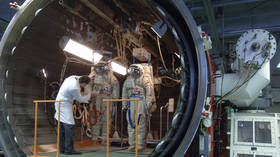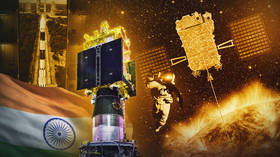Astronauts may wear Russian suits for India's first manned mission – media

Indian astronauts taking part in the country's first manned space mission, ‘Gaganyaan’ – scheduled for next year – are likely to wear Russian-made suits, The Hindustan Times has reported, citing documents accessed by the outlet.
According to the report, the Indian Space Research Organization (ISRO) will likely make the choice “considering the programmatic requirements and to doubly ensure the crew safety.”
This is despite India developing its own Intra Vehicular Activity (IVA) suits for the mission, with the work about to be completed, the outlet added.
India has been closely working with Russia on the $1.4 billion ‘Gaganyaan’ mission under various agreements on space cooperation, signed by the leaderships of the two countries, including the 2018 pact on collaboration in human spaceflight. India then sought help from Russia in specific areas of the ‘Gaganyaan’ program, including life-support systems, crew modules and astronaut training.
During his visit to Vladivostok in 2019, India’s Prime Minister Narendra Modi noted that India and Russia’s “long association in space is touching new heights.”
In 2020, four Air Force pilots selected by the ISRO traveled to Russia for generic space flight training at the Gagarin Cosmonaut Training Centre in Star City, outside Moscow. Since their return, the astronauts have been continuing their training for the mission in India.
In September last year, the astronauts visited the Moscow-based manufacturer Zvezda, where their anthropometric parameters were measured for the production of spacesuits, Glavkosmos, a subsidiary of the Russian space agency Roscosmos, said in a statement. However, ISRO scientists who spoke to The Hindustan Times refused to confirm that Indian astronauts will using Russian suits for the mission.
S Somanath, chairman of the space agency, earlier this month said that 2024 will be the “year of Gaganyaan readiness.” The mission, likely to be launched in 2025, will see India test its spaceflight capability by launching a three-member crew to an orbit of 400 km.
A series of tests are expected to be conducted in the months leading up to the launch. This includes a test flight with a humanoid robot named Vyomitra, and an unmanned flight before the manned mission.
In October last year, ISRO launched the first of a series of test flights in preparation for the Gaganyaan. The basic crew module in the mission turned upside down while being recovered by naval divers in the sea. This year, the space agency will experiment with a crew module to ensure that it remains upright after splashing down in the sea.
In 2023, the Indian space agency achieved several landmark moments as it launched its Chandrayaan-3 mission to the south pole of the Moon. In September, the agency launched the country’s first mission to the Sun, a solar observatory called Aditya-L1. Last week, the mission was successfully placed into orbit, from where it will make observations for the next five years. Inspired by ISRO’s success in landing on the Moon, Indian Prime Minister Narendra Modi urged the space agency to aim to set up India’s own space station by 2035 and send the first Indian to the Moon by 2040.
Where India Meets Russia – We are now on WhatsApp! Follow and share RT India in English and in Hindi














